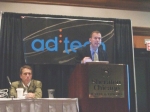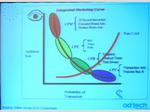TV Is Changing And TV Companies Better Follow

Facts and figures were prevalent in this ad"tech Chicago 2006 TV 2.0 panel with Denuo SVP Tim Hanlon and Points North Partners Founder Peter Storck. Both spoke of the dramatic changes TV is undergoing right now and where they thought it was heading. Storck began with a numbers-heavy presentation that revealed many insights from various studies about the use of TV and the DVR:
1. 33 percent want TV-like features of their PCs
2. 15 percent want them on their cell phone
3. 46 percent use their DVRs to skip commercials
4. 58 percent use their DVR to record programming
5. 35 percent use their DVR to pause live TV
6. 49 percent use their DVR every day
7. 63 percent use it once a week
8. 55 percent fast forward through commercials
9. Interestingly, 15 percent use thir DVRs to rewind and watch commecials
10. 42 percent use free video on demand
11. 59 percent use the DVR to access free local information
Storck then shifted to video ono the web and saif 32 percent watch news videos and 31 percent watch movie previews. In terms of video on mobile phones 32 percent say the screen is too small and 30 percent the content isn't worth watching.
While programming certainly is shifting towards a more on-demand, paid model, 62 percent of people would still rather watch ad-supported content than pay for d-free content. Of those who would pay, 17 percent would pay $1.99 per show.
While Storck believes people are behind the industry in terms of shifting to newer viewing models, Denuo's Hanlon believes the consumer is ahead of the industry. While listening to Hanlon's very vibrant and intellectual presentation, I felt like I had to bring up the thesaurus to aid in my interpretation of his use of several "fancy" words. That aside, Hanlon share the inter-relationship bewteen small and large audiences and the cost models used to price reach to those audiences. The accompanying chart will show how those relationships change as the audience size changes.
Hanlon asserted people want content to be malleable, flexible and viewed on their own terms. Because of the change in viewing habits, he claims metrics such as Nielsen television rating are woefully out of date and do not adequately capture the use of the medium.
He gave a couple examples of companies that are accommodating this shift in consumption citing TiVo's telescoping ads which let viewers dig deeper into advertising content without missing any programming. He also told the audience to, when in a Starbucks, dial 510-653-6473 and hold the phone up to the music. It's the Grace Notes services that provides song information. He says there's no reason this or similar technology couldn't be harnessed to provide a channel to offer people more information on ads of any kind.
People want flexibility in how they access content and Hanlon says "tough shit" to old content companies who are clinging to old models becasue there won't be much to cling to for much longer. As the quantity of content increases and more control is ceded to the viewer, the need for guidance and navigation ill become necessary giving rise to a whole new category of company whose sole purpose is to present choices in an easy to navigate fashion.
While Hanlon does not believe mass media will die, he does believe it will become the exception to the rule. In terms of ad-free, paid content, Hanlon does belive that will continue to increase but not necessarily at the expense of ad-supported media because there's a limit to how much anyone will pay before it starts to hurt.



Comments
Great statistics. If only Big Media and content providers would listen to the people. I can't wait for searchable TV and program guides - with or without a couple of advertisements.